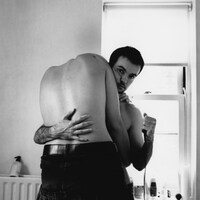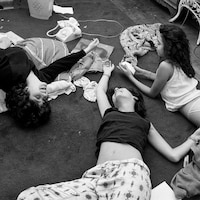‘It’s like having a loaded gun, but it hasn’t got a safety’: Charlie Birch’s ‘deeply personal’ short film and photo book share the story of a young ex-offender trying to rebuild his life with the help of his beloved dogs
“When you’re in jail, you’ve got a lot of time on your hands”, says the voice of Joseph in Loaded Gun, a short film by Charlie Birch that accompanies a photo book of the same name. “Whilst I was there I was thinking about what I’d do when I get out”. Once the time came, Joseph – or Jay, as Birch refers to him – settled on the responsibility of owning dogs, a childhood fascination he’d carried on into later life. “It’s not just about dogs, it’s about finding a passion and using that passion to distract you from what used to lead you away, down a wrong path or down the bad thoughts you’re struggling with at that moment in time.”
Birch first encountered Jay just a couple of months after his release, walking a huge Caucasian Shepherd through the streets of his native Liverpool. The pair established an immediate rapport, chatting about photography and bonding over their shared childhood experiences with pet dogs (Birch grew up with Rhodesian Ridgebacks around the house). From that very first encounter, Loaded Gun was born.
The project is a deeply personal piece that charts both Jay’s own journey in rehabilitation and the perception of “dangerous” dog breeds in an uninformed society. Birch’s photographs, at once serene and arresting, expertly draw parallels between these two things via the metaphor of a firearm. In the book, images of calmness and tranquillity sit beside those of anger and abjection, forcing the viewer to wonder, of man or dog, who is the loaded gun?
In the following conversation, we chat to Birch about his relationship with Jay, the emotional intensity of the project, plus an exclusive premiere of his Loaded Gun film below.
To begin, please can you tell me a bit about how your relationship with Jay came about?
Charlie Birch: I moved back up north from Amsterdam – which had been home for four years – moving in with my family who live in a village on the Merseyside border. I would go into the city to wander, photographing anyone who’d let me. One afternoon Jay walked past me with this beautiful dog, a Caucasian Shepherd.
What qualities attracted you to Jay as a subject?
Charlie Birch: At first it was purely aesthetical, the combination of this gigantic rare breed of dog and this young lad in 110s and a Mountain Equipment jacket, so we began to chat. I’ve grown up with Rhodesian Ridgebacks which is another gigantic and pretty rare breed in the UK, so we had a lot to talk about.
He was charismatic, a little bit mental, and really enthusiastic to chat about dogs and photography. I think he’d been out of jail for two months at that point and mentioned to me recently how thankful he was to chat to someone that day.
When did you begin photographing Jay for the book? Was there an exact moment of inspiration that led you to create the work?
Charlie Birch: From the first day I met him, I kept my camera on me. At that first encounter, I managed to get a handful of images, one of which can be found in the book. It’s noticeable as it’s the only non-bulldog featured.
I was going through a lot at that time, and so was he. So we used to chill together and talk about life, passing on knowledge from our very different life experiences. The project seemed to unveil itself slowly and I’d start to draw connections between conversations and photographs. Similarities in Jay’s nature and the dogs became apparent.
“He says ‘it’s like having a loaded gun, but it hasn’t got a safety’... although Jay is talking about the dog, sometimes it seems he could be talking about someone like him” – Charlie Birch
Can you explain a bit more about the name of the piece?
Charlie Birch: I filmed a short documentary whilst making the book and I interviewed Jay to get his narration. Towards the end he talks about these types of dogs being very capable and that they’ve been in the media a lot recently. He says, ‘It’s like having a loaded gun, but it hasn’t got a safety that you can flick, the safety is in the own dog’s head.’
What interests me about this project is, although Jay is talking about the dog, sometimes it seems he could be talking about someone like him. You can swap dog for man and the narrative stays the same. The last page of the book is me asking ‘who is the loaded gun?’ I feel it’s the perfect name and idea to base the book around.
There’s quite a contrast between the area of Kensington in Liverpool that Jay grew up in, to the other more well-known Kensington in west London. Was this an association you picked up on? And how do you think that association plays out when we think about class in this country?
Charlie Birch: No, it isn’t something I considered. Kensington in Liverpool is worlds apart from the affluence of Kensington in London. It just seemed like a funny coincidence. The obvious association is that they’re polar opposites of the economic spectrum. I find it interesting that both places exist, one is famous and the other unknown. That seems to say a lot about us as people at the moment – wealth is celebrated and poverty silenced.

In what ways did you form a relationship with Jay while shooting, to gain his trust?
Charlie Birch: Like I mentioned earlier, we were both going through it in our own ways at the time, and I think that helped bring us to a certain level with each other, although I can’t really take credit for Jay being great. He’d never met someone with aspirations similar to mine, he didn’t bat an eyelid, never judged. I’d have open conversations about what I was trying to do, what I wanted to say, who I thought it could help, and he trusted me.
The work is emotionally quite up and down. In most photos, Jay is serene and content, and the dogs are too, but there are also pictures of walls with holes punched in them. What kinds of emotional states were you expecting to draw from viewers of the piece?
Charlie Birch: I wanted to portray the erratic nature of rehabilitation for him and so many others – someone trying to carve out a brand new life on their own, with no adult figures to help guide them. There is no consistency, each day is a whirlwind, physically and emotionally, and anything can happen. It’s about balance, understanding trauma and battling it head-on. Anyone battling their own demons knows it’s up and down, moments of bliss and moments of rage. I wanted this to be present within the book. That’s also why there is such a mixed image approach, with some really distressed and heavily worked images, and some more classical.
I also tried to show his character, especially in the portraits of him, celebrating him as an individual. After everything the world throws at him and all the harm caused, there is a lovely person who just wants a normal life.
“There’s no pride in crime, and a dog has no pride in biting somebody. It does it because it’s scared” – Charlie Birch
So is prison reform and rehabilitation the guiding principle of the work?
Charlie Birch: To a certain extent yes, the prison system as a whole in the UK is pretty broken. I hope to offer a new perspective on how, hypothetically, we could use animals as a way to bring people on the cusp of life back to reality. I know as an idea it isn’t perfect, but it’s a start. I’ve also personally seen dogs help many outside of the prison system – close family, people I chat to on the street – but we don’t hear these stories, so this project was aiming to be a celebration as much as everything else.
There’s no pride in crime, and a dog has no pride in biting somebody. It does it because it’s scared. I'd also say the guiding principle of the work is the nature vs nurture debate. There’s that quote ‘hurt people hurt people’... seems fitting.
If anything, what do you think people are most likely to misinterpret about this body of work?
Charlie Birch: I think some viewers could see the project as glamorising dangerous dogs and advocating for criminality. But I’m trying to use these subjects as a way to have new conversations about healing and men’s mental health. Taking an aesthetically aggressive subject and trying to get into the emotional side of it, to show a real depth. I believe this will be the heart of all my work moving forward. I’m able to make people feel comfortable around me and my camera – pointing it at subjects that are only seen from one perspective and giving people a new voice is really exciting for me.
Loaded Gun exhibition and screening takes place July 26, 6-9pm at Photo Book Cafe, 4 Leonard Circus, London, EC2A 4DQ. Click here to RSVP.
Join Dazed Club and be part of our world! You get exclusive access to events, parties, festivals and our editors, as well as a free subscription to Dazed for a year. Join for £5/month today.










